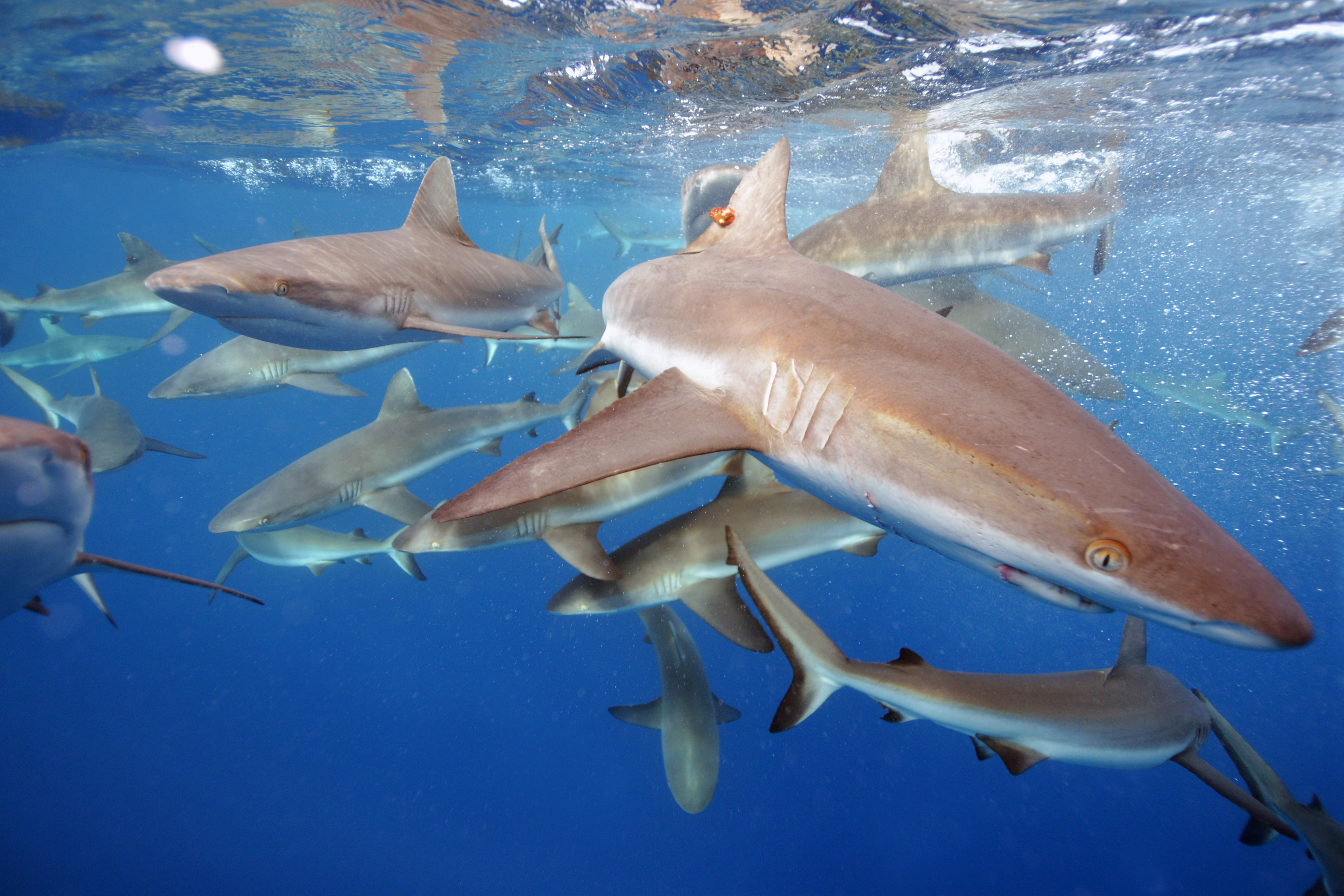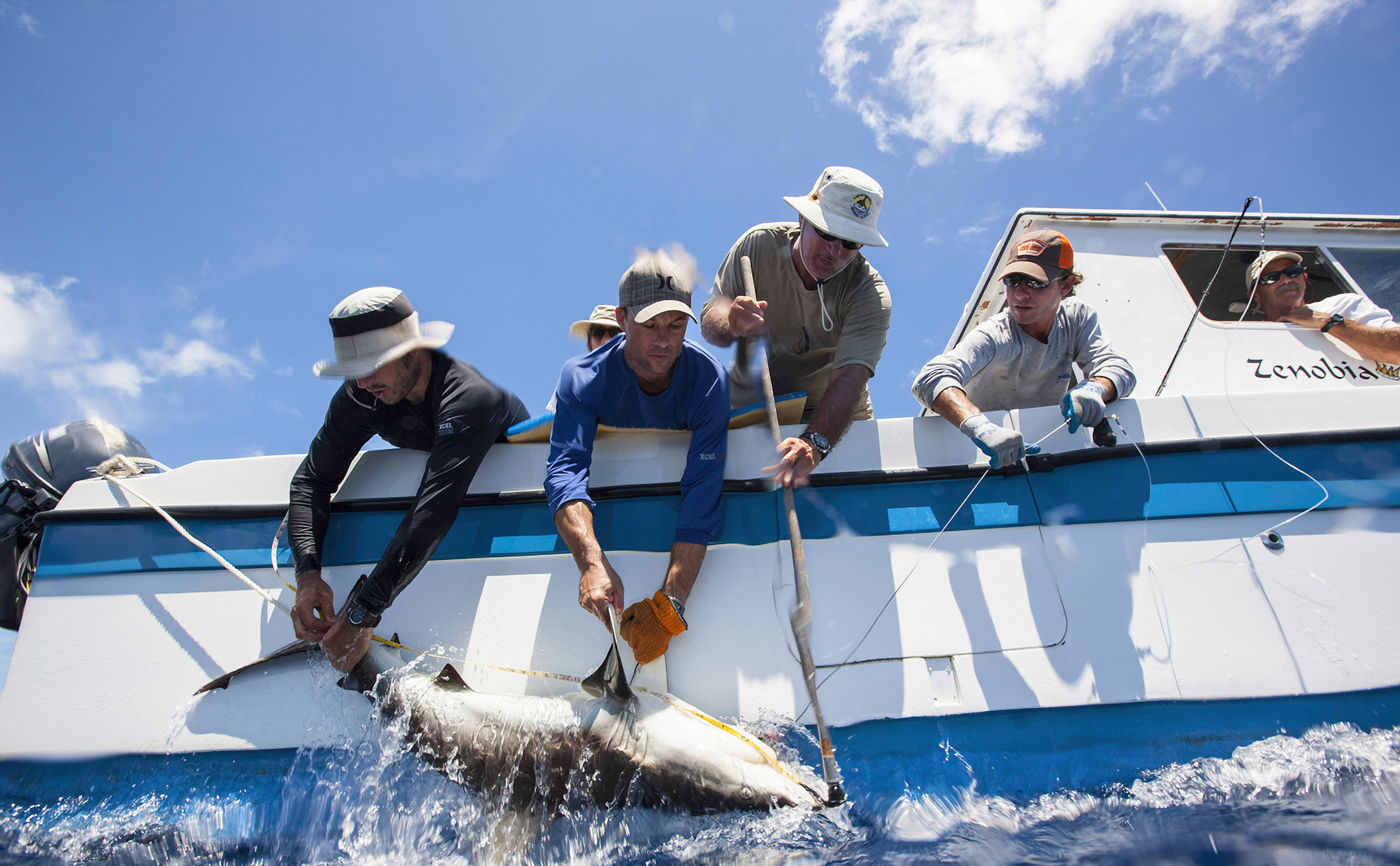Shark Study Sets Baseline for Healthy Populations

Gray reef sharks, Palmyra Atoll. Photo © Kydd Pollock/Nature Conservancy
Results from an eight-year shark tagging project indicates a healthy shark population can be smaller in size than originally thought.
The study, led by The Nature Conservancy and the University of California at Santa Barbara was conducted at Palmyra Atoll, an isolated national wildlife refuge 1,000 miles south of Hawai‘i.
The research has helped to establish what scientists are calling “a much needed baseline” for what constitutes a healthy shark population.
“The findings offer both good and bad news,” said Dr. Eric Conklin, director of marine science for The Nature Conservancy’s Hawai‘i and Palmyra programs. “On the one hand, they suggest declining world shark populations may be more precarious than previously thought. But they also suggest that restoring those populations may not be an unobtainable goal.”

Scientists aboard a research boat implant a tracking transmitter on a grey reef shark at Palmyra Atoll. Photo © Tim Calver/Nature Conservancy
Marine scientists have found that the healthiest coral reef ecosystems have robust populations of sharks and other apex predators like jacks and grouper. But exactly what role sharks play in maintaining reef health is not known.
With world shark populations in sharp decline—for some species, population loss is as high as 90%— researchers were in search of important baseline information on what constitutes a healthy population.
Another key finding is that reef sharks at Palmyra tend to stay within the atoll and do not travel great distances, as preliminary results had suggested.
External tags and implanted acoustic transmitters used to document the sharks’ movements have given researchers a better understanding of how sharks are utilizing habitat throughout Palmyra’s reefs and lagoons. It also indicates island states and territories may be able to restore their own shark populations by setting up marine managed areas of sufficient size to protect sharks throughout their home range.
ARTICLE CONTINUES BELOW ADBetween 2006 and 2014, researchers tagged 1,300 reef sharks at Palmyra and fitted them with numbered ID tags.
Of the 1,300 tagged sharks, 350 individuals were recaptured—the largest reef shark tag recapture program in the world. In addition, researchers recorded information on the sex and size of each animal, the location of its capture, and fitted some sharks with acoustic telemetry tags which broadcast the shark’s location to an extensive system of receivers located around the atoll. Researchers then plugged all the data into an algorithm that estimated the total population size.
The Results Were Surprising:
“We estimated there are between 6,000 to 8,000 gray reef sharks at Palmyra, which works out to a density of about 20 sharks per square kilometer,” said Dr. Darcy Bradley, the study’s lead author and a postdoctoral researcher with UCSB’s Bren School of Environmental Science & Management and The Nature Conservancy’s California program.
“That’s far fewer than we expected. Previous research that used underwater visual survey methods estimated a density of between 200 to 1,000 sharks per square kilometer, which would scale up to a much larger population.”
Conklin said the discrepancy between the study’s findings and earlier visual estimates is likely due to behavioral factors, not a decline in the atoll’s shark populations.
“When marine scientists first began conducting research at Palmyra, they would be surrounded by sharks whenever they jumped in the water,” he said. “But over time, as the sharks have become accustomed to seeing people, they are no longer quite as curious about our presence.”
The density of sharks at Palmyra is still remarkable, Conklin added, especially when compared with the main Hawaiian Islands. “When you dive in the nearshore waters around Hawai‘i, it’s very rare to see a shark,” he said. “In Palmyra, it’s very rare not to see several.”
“With so many sharks in one place, and so few humans, the atoll makes it possible to study sharks in their natural densities,” Conklin said. “As a result, we now know what a healthy shark population looks like on an un-fished reef. And while the results are something of a mixed blessing, the information fills an important gap in helping us understand the relationship between healthy shark populations and healthy coral reefs.”
Palmyra Atoll, a Nature Conservancy preserve and a US Fish & Wildlife Service national wildlife refuge with 15,000 acres of surrounding coral reefs, is one of the few places left where sharks and other large apex predators dominate the marine ecosystem. The refuge is off limits to commercial fishing, and with the exception of its occupation by the US military in World War II has never had a permanent human settlement.
Other participating researchers in the study included Kydd Pollock of The Nature Conservancy; Douglas McCauley, Bruce Kendall, Steven Gaines and Jennifer Caselle from UCSB; Yannis Papastamatiou of Florida International University and Amanda Pollock of the US Fish and Wildlife Service. Study results appear in the journal Scientific Reports.










